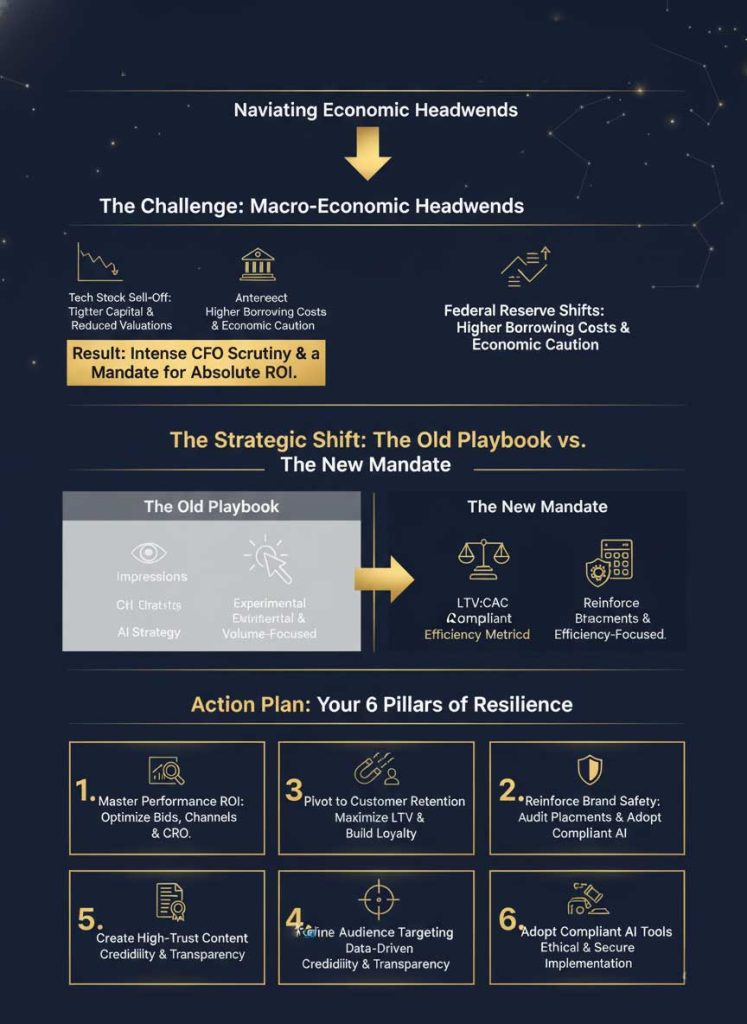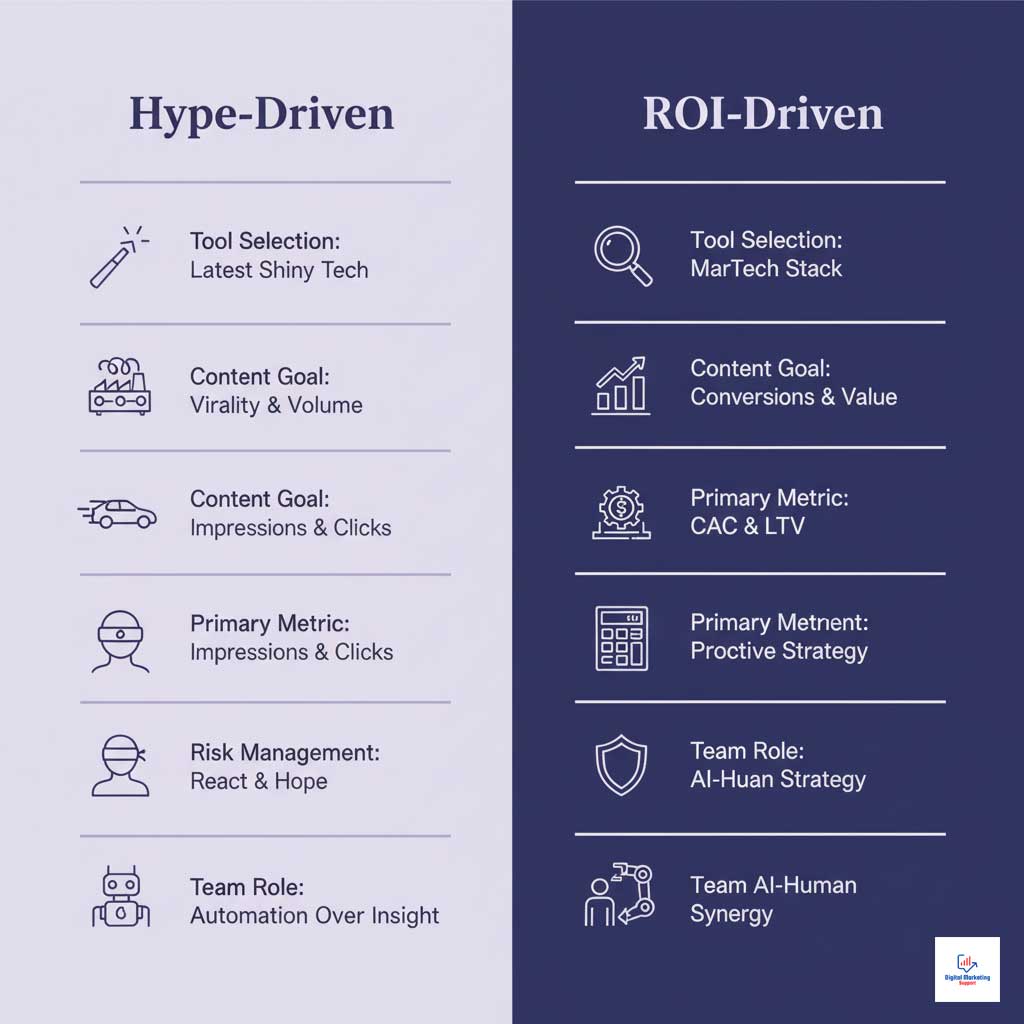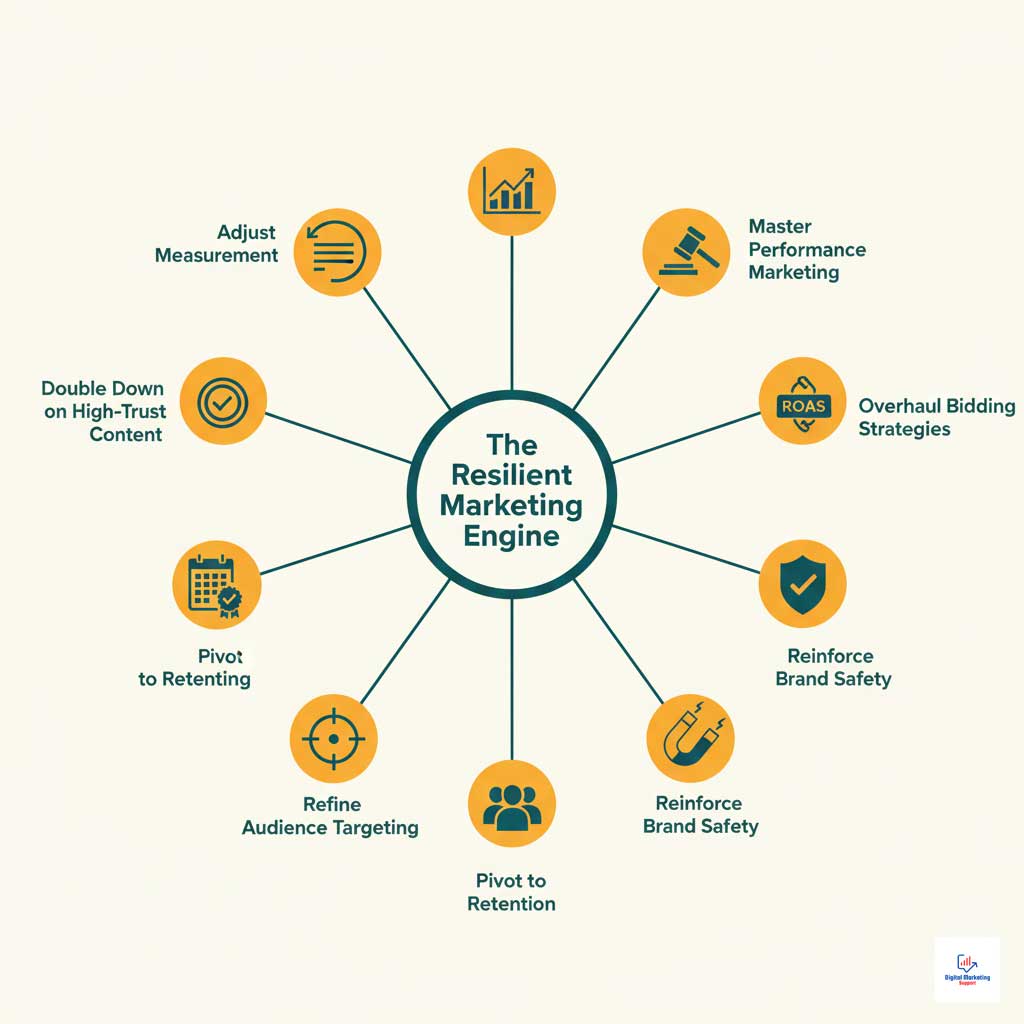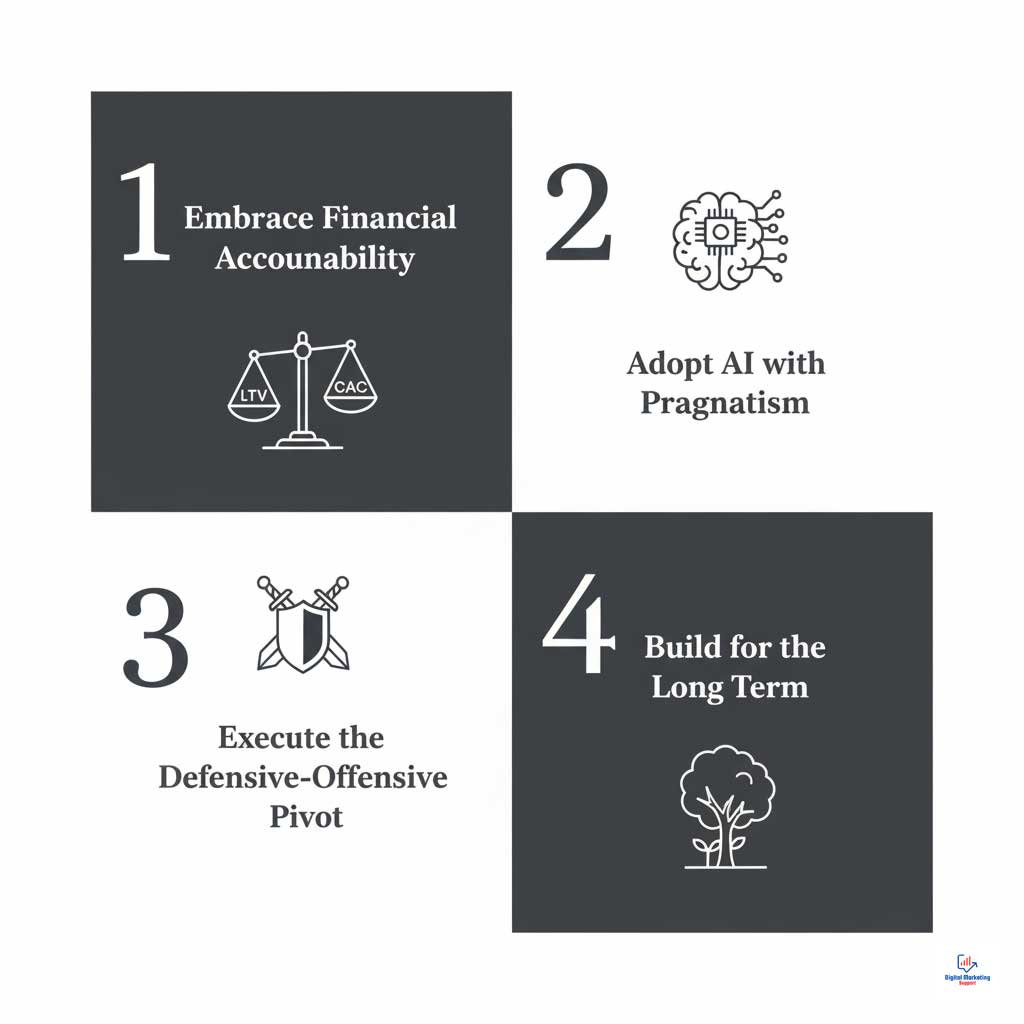The perfect storm has arrived for US digital marketers. In the final quarter of 2025, the confluence of a highly volatile tech sector, marked by significant swings in the NASDAQ, and the Federal Reserve’s unwavering stance on maintaining higher interest rates has created an economic pressure cooker. This is not a fleeting market tremor; it represents a fundamental recalibration of business priorities, directly impacting every facet of marketing. The era of growth-at-all-costs, lavishly funded by cheap capital, has decisively ended.
Table of Contents
In its place is a new mandate from the C-suite, particularly the CFO: ruthless efficiency. Every dollar in the marketing budget is now under a microscope, and the pressure to justify spend with hard, financial metrics has never been more intense. The tech stocks market impact on marketing is no longer a theoretical discussion—it’s a daily reality of shrinking client retainers, cautious consumer spending, and an urgent need for demonstrable ROI.

To survive and thrive in this landscape, digital marketers must execute an immediate and strategic pivot. This guide provides an essential playbook for navigating digital marketing during market volatility, detailing the critical shifts required in ad budgets, AI adoption, and content strategy for a US-focused audience.

Understanding the Macroeconomic Shockwaves: Why This Time Is Different
For marketers to adapt effectively, they must first grasp the two primary forces reshaping their operational reality. These are not just abstract financial headlines; they are direct drivers of your budget and strategy for the foreseeable future.
The first force is the ongoing tech stock correction. In simple terms, investor sentiment has shifted dramatically from rewarding long-term growth potential to demanding immediate profitability. When iconic tech companies see their valuations fall, it triggers a chain reaction: access to capital tightens, expansion plans are shelved, and internal cost-cutting becomes paramount. For marketers, this translates directly into smaller budgets and a reduced appetite for experimental campaigns.

The second, and arguably more impactful, force is the Federal Reserve’s role in managing the economy. By maintaining higher interest rates, the Fed makes it more expensive for businesses to borrow money for everything from payroll to new initiatives. This has a profound Fed rate cut impact on advertising budgets; when the cost of capital is high, companies preserve cash. Marketing, often viewed as a discretionary expense, is frequently one of the first areas to face scrutiny, making ad spend optimization during recession risk a critical survival skill.
The CFO’s Mandate: How Ad Budgets and KPIs Are Shifting in 2025
The most immediate consequence of this macroeconomic pressure is the dramatic shift in how marketing success is measured. The CFO’s voice is now the loudest in budget allocation meetings, and their priorities have fundamentally altered the marketing landscape. This is the new reality of CFO marketing budget priorities 2025.
From “Growth” to “Efficient Growth”: The New KPI Dashboard
For years, marketing dashboards have been dominated by top-of-funnel and vanity metrics: impressions, reach, click-through rates, and follower growth. While still relevant for diagnostics, these are no longer the metrics that secure budgets. The new mandate is for “efficient growth,” measured by a dashboard of hard financial KPIs.
- Customer Acquisition Cost (CAC): The total cost to acquire a new customer. The focus is on lowering this figure relentlessly.
- Lifetime Value (LTV): The total revenue a business can expect from a single customer account. The goal is to increase this through retention and upselling.
- LTV:CAC Ratio: This is the golden metric. A healthy ratio (typically 3:1 or higher) proves that your marketing efforts are not just acquiring customers, but profitable ones.
- Payback Period: The time it takes for a customer to generate enough revenue to cover their CAC. Shorter is always better.
A recent Gartner CMO survey underscored this trend, revealing that 65% of CFOs are now asking their marketing counterparts to improve CAC efficiency by at least 15% in the coming two quarters. Effective digital marketing during market volatility means speaking the language of finance.

The Impact on Channel Mix: Where the Money is Moving
This focus on efficiency is forcing a strategic reallocation of funds across the marketing mix. A crucial strategy for survival is programmatic ad reallocation during downturn, moving budgets away from channels with long or murky payback periods toward those with clear, measurable, and immediate returns. An audit of your channel mix is no longer an annual exercise; it’s a quarterly, if not monthly, necessity.
These strategic budgeting shifts represent a new framework for resource allocation as marketers decide how marketers should reallocate ad spend after tech stock correction.

Digital Marketing Budget Reallocation Priorities During Market Volatility
| Channel/Tactic | Action (Increase/Decrease/Maintain) | Rationale | Key Metric to Track |
| Paid Search (High-Intent) | Increase / Maintain | Captures existing demand with high conversion potential, directly linking spend to revenue. | ROAS / Cost Per Conversion |
| SEO & Content Marketing | Increase | Builds a long-term, defensible asset (organic traffic) at a lower long-term cost, reducing reliance on paid media. | Organic Leads / Keyword Rankings |
| Programmatic Display (Prospecting) | Decrease | Reduces spend on low-conversion, upper-funnel awareness campaigns with difficult-to-measure ROI. | View-through Conversions |
| Retention (Email/SMS/Loyalty) | Increase | It is 5-25x more cost-effective to retain existing customers than acquire new ones, directly boosting LTV. | Customer Lifetime Value / Churn Rate |
| Experimental (e.g., Metaverse) | Decrease / Pause | Halts cash-intensive activities with unproven ROI to preserve capital for core, profitable channels. | N/A |
| Performance Social (Retargeting) | Maintain | Nurtures warm audiences who have already shown intent, leading to higher conversion rates. | CPA / Conversion Rate |
The AI Hype Correction: Separating ROI from the Hype
Simultaneously, the marketing world is grappling with a second major shift: the end of the AI honeymoon. The initial, unbridled enthusiasm for generative AI is now being tempered by pragmatic questions of value, risk, and cost. This marks the beginning of the AI valuation pullback marketing strategy, where the adoption of AI is no longer about innovation for innovation’s sake, but about driving tangible business outcomes.
Legal & Compliance: The Generative AI Risk You Can’t Ignore
The most significant headwind for the AI hype train has been the emergence of serious legal challenges. Landmark rulings, such as the Getty Images vs. Stability AI case in the UK, have established precedents that AI model creators can be held liable for copyright and trademark infringement. This legal uncertainty places a massive burden on marketing teams to ensure compliance.
An effective AI valuation pullback marketing strategy involves mitigating these risks. When evaluating tools, you must move beyond features and demos to scrutinize the legal fine print. Marketers should create a mini-checklist for vetting potential AI vendors, focusing on:
- Data Transparency: Does the vendor clearly disclose the data used to train their models?
- Commercial Indemnification: Does the vendor offer legal protection (indemnification) against copyright claims arising from the use of their tool?
- Clear Licensing: Are the terms of use for generated assets clear, unambiguous, and suitable for commercial use?
- Enterprise-Grade Security: Does the tool meet your company’s data privacy and security standards?
Choosing the best AI tools for marketing when investor sentiment shifts means prioritizing safety and compliance over flashy, unvetted features.
Creative Strategy: Prioritizing AI Content Quality vs. Hype-Driven Creative
The market is now flooded with content that is transparently AI-generated—it’s often generic, lacks a unique point of view, and fails to resonate with audiences. This highlights the critical debate of AI content quality vs. hype-driven creative. A strategy focused on simply churning out massive volumes of AI content is doomed to fail.
Audiences crave authenticity and expertise. The true power of AI lies not in replacing human creatives, but in augmenting their abilities. It can be a world-class brainstorming partner, a tireless research assistant, or an efficient first-draft generator. But the final product must be shaped by human experience, brand knowledge, and strategic insight to be effective. The brands that win will be those that use AI to make their human talent more creative and efficient, not obsolete.

Comparison: Hype-Driven vs. ROI-Driven AI Marketing Strategy
| Aspect | Hype-Driven AI Approach | ROI-Driven AI Approach |
| Tool Selection | Adopts the newest, most talked-about generative AI tools without a clear use case. | Selects tools based on specific workflow efficiencies (e.g., automating ad copy variations) and proven ROI. |
| Content Goal | Maximize content volume and publishing frequency, often at the expense of quality. | Improve content quality, personalization at scale, and conversion rates on key assets. |
| Primary Metric | Number of assets created; speed of production. | Cost savings per asset; increase in lead quality; conversion lift from A/B testing AI-generated variants. |
| Risk Management | Ignores or downplays potential copyright, brand voice, and compliance issues. | Conducts rigorous legal and security reviews before implementation and establishes clear usage guidelines. |
| Team Role | Sees AI as a low-cost replacement for creative professionals like writers and designers. | Views AI as a co-pilot or intelligent assistant to augment human creativity and strategic expertise. |
The Marketer’s Tactical Playbook: 7 Essential Changes to Make Now

Understanding the macro environment is only the first step. Survival and success in 2025 and beyond require immediate, decisive action. A tactical playbook for this new era requires seven essential changes.
1. Master Performance Marketing Under Tighter Macro Conditions
The shift to efficiency puts performance marketing at the center of the universe. But simply running paid search and social campaigns is no longer enough. Mastering performance marketing under tighter macro conditions requires an obsessive focus on bottom-funnel optimization.
Relentless Conversion Rate Optimization (CRO)
Your website and landing pages are your most critical assets. Implement a continuous CRO program, A/B testing every element of the conversion path: headlines, calls-to-action (CTAs), page layouts, and form fields. A 0.5% improvement in your landing page conversion rate can dramatically lower your effective CAC.
Aggressive Creative and Copy Testing
Use AI-powered tools to rapidly generate dozens of ad copy and creative variations, but use human oversight to select the most promising candidates for testing. Test different value propositions, emotional hooks, and visual styles to find the combinations that resonate most strongly with a cost-conscious audience.
2. Overhaul Your E-commerce Bidding Strategies During Market Volatility
For e-commerce brands, auction dynamics can change overnight. A successful approach to adjusting e-commerce bidding strategies during market volatility hinges on agility and a focus on profitability over volume.
Shift from Target CPA to Target ROAS
While Target CPA (Cost Per Acquisition) focuses on the cost of a single conversion, Target ROAS (Return On Ad Spend) optimizes for total conversion value. In a volatile market, focusing on ROAS ensures that every ad dollar spent is driving a profitable return, even if overall transaction volume fluctuates.
Implement Value-Based Bidding
Connect your CRM or backend data to your ad platforms to bid more aggressively for traffic likely to convert into high-LTV customers. This moves beyond treating all conversions as equal and focuses your budget on acquiring your most valuable customer segments.
3. Reinforce Your Brand Safety & Programmatic Guardrails
In a tense economic and political climate, the risk of your brand’s ads appearing next to inappropriate or off-brand content skyrockets. A key component of programmatic ad reallocation during downturn is not just about where you spend, but where you don’t.
Your brand safety strategy should include:
- Dynamic Keyword Exclusion Lists: Actively update your negative keyword lists with terms related to trending negative news cycles to prevent contextual ad placements.
- Placement Audits: Regularly review your placement reports in Google Ads and other DSPs to identify and exclude low-quality or irrelevant websites and apps that are wasting your budget.
- Third-Party Verification: Employ services like DoubleVerify or Integral Ad Science to ensure your ads are viewable, fraud-free, and served in brand-safe environments.
4. Pivot from Broad Prospecting to LTV-Focused Retention
Customer acquisition is expensive, and in a downturn, it gets even harder. The most financially sound strategy is to shift focus and budget toward your existing customer base. It’s time to double down on retention.
Your retention marketing toolkit should be your top priority. This includes:
- Personalized Email and SMS Flows: Use your first-party data to create highly targeted campaigns, such as abandoned cart reminders, cross-sell recommendations, and loyalty-based promotions.
- Exclusive Offers for Loyal Customers: Reward your best customers with early access, exclusive discounts, or value-added services. This not only drives repeat purchases but also builds a loyal community around your brand.
5. Refine Audience Targeting When CPMs Fall
It can be tempting to celebrate when you see CPMs (Cost Per Mille) decrease, as it means your ad dollars are buying more impressions. However, this is often a trap. Audience targeting when CPMs fall is critical because lower costs can signal lower-quality inventory or reduced consumer intent.
Instead of broadening your targeting to capture cheap impressions, do the opposite: narrow it. Focus your spend on your highest-intent audiences, such as:
- First-Party Data: Your website visitors, past purchasers, and email subscribers.
- High-Fidelity Lookalike Audiences: Create lookalike audiences based on your highest-LTV customer segments, not just all customers.
6. Double Down on Content Formats That Outperform During Macroeconomic Uncertainty
During times of financial anxiety, consumers and business buyers become more risk-averse. They spend more time researching purchases and seek out content that helps them make safe, justifiable decisions. The content formats that outperform during macroeconomic uncertainty are those that build trust and demonstrate tangible value.
Prioritize creating:
- Case Studies and Testimonials: These provide social proof and show real-world success.
- ROI Calculators and Tools: Interactive tools that help prospects quantify the value of your offering.
- Detailed Competitor Comparison Guides: Help buyers make an informed decision by transparently comparing your solution against alternatives.
- Original Research and Data Reports: Position your brand as an authority and create a valuable asset that attracts backlinks and media attention.
7. Adjust Your Measurement and Attribution Windows
When money is tight, the customer journey often gets longer. Buyers take more time to evaluate their options, seek more approvals, and delay purchase decisions. Your measurement strategy must adapt to this new reality. A last-click attribution model will undervalue the upper-funnel marketing efforts that initiated the journey. Consider switching to a data-driven or position-based attribution model to better credit the full spectrum of touchpoints influencing the final conversion.
Summary & Key Takeaways: Building a Resilient Marketing Engine
The convergence of the tech stock sell-off and the Federal Reserve’s policy shifts has created a challenging but ultimately clarifying moment for digital marketers. The tech stocks market impact on marketing is a powerful catalyst for positive change, forcing a long-overdue evolution toward a more accountable, data-driven, and customer-centric discipline. The principles of ad spend optimization during recession risk are not just defensive maneuvers; they are the foundation of a more resilient and efficient marketing engine for the future.

The key takeaways for every marketer navigating this new terrain are clear:
- Embrace Financial Accountability: Budget scrutiny is the new normal. Learn to speak the language of the CFO and anchor your strategy in hard metrics like CAC, LTV, and ROAS. Your ability to prove marketing’s contribution to the bottom line is your greatest asset.
- Adopt AI with Pragmatism: The AI hype cycle is maturing. Move beyond experimentation and focus your AI valuation pullback marketing strategy on tools that solve concrete business problems, drive measurable efficiencies, and pass rigorous legal and compliance checks.
- Execute the Defensive-Offensive Pivot: Immediately shift budget from broad, upper-funnel prospecting to high-intent performance channels and LTV-focused customer retention. This is the core of effective digital marketing during market volatility.
- Build for the Long Term: The brands that master performance marketing under tighter macro conditions and invest in durable assets like SEO and customer loyalty will not only survive this downturn but will emerge with greater market share and a more sustainable growth model.
This strategic framework should serve as a checklist to audit current strategies and present a proactive plan to leadership. The marketers who act decisively now to align their operations with this new economic reality will be the ones who define the next era of digital marketing leadership.
Frequently Asked Questions (FAQs)
How do Fed rate expectations change digital advertising budgets?
Higher Federal Reserve rate expectations increase the cost of capital for businesses, leading to tighter overall budgets. For digital advertising, this typically triggers a strategic reallocation of funds, moving spend away from long-term brand-building campaigns and toward highly measurable performance marketing channels like paid search and retention marketing that promise a more immediate and predictable return on investment.
Should marketers cut ad spend when tech stocks decline?
No, a blanket cut is rarely the right answer. Decades of research show that brands that strategically maintain their marketing presence during economic downturns often gain significant market share. The smarter approach is to reallocate budgets to more efficient, high-ROI channels and intensify the focus on retaining your most valuable existing customers.
Which AI marketing tools are safe to use after generative-AI copyright rulings?
The safest AI tools are typically those from established, enterprise-focused vendors who offer commercial indemnification, meaning they provide legal protection against copyright claims. Prioritize platforms that are transparent about their model’s training data and provide clear commercial licenses for all generated content.
How can I optimize programmatic buys during global market sell-offs?
During a market sell-off, you should optimize programmatic buys by tightening your audience targeting to focus on first-party data and high-intent segments. It’s also crucial to aggressively use keyword and placement exclusion lists to ensure brand safety and avoid wasting impressions on low-quality or non-relevant inventory.
What content formats convert best during periods of economic uncertainty?
Content formats that build trust and clearly demonstrate value perform best. These include detailed customer case studies, ROI calculators that quantify your product’s financial impact, in-depth competitor comparison pages, product tutorials, and authentic video testimonials from satisfied clients.
How do I protect my brand safety when a major political or corporate scandal is trending?
Protect your brand by using dynamic keyword exclusion lists to block your ads from appearing alongside negative news stories. You should also consider temporarily pausing any campaigns that are contextually targeted to news categories and work with third-party ad verification partners to monitor your placements in real-time.
At what point should my performance marketing shift from prospecting to retention?
The pivot toward retention should intensify as soon as you see your customer acquisition costs (CAC) begin to rise and your conversion rates on prospecting campaigns start to decline. In a challenging economic climate, it is almost always more profitable and sustainable to market to your existing customers than to acquire new ones.
What KPIs should I prioritize if my CPMs are falling but conversion intent seems weaker?
If CPMs are falling but conversion intent is low, you must ignore vanity metrics like impressions and clicks. Prioritize bottom-of-the-funnel financial metrics instead. Your new dashboard should be focused on Cost Per Acquisition (CPA), Return on Ad Spend (ROAS), and Customer Lifetime Value (LTV) to get a true measure of profitability.
How does the current AI valuation pullback affect my marketing technology stack?
It should trigger a strategic audit and consolidation of your tech stack. The focus is shifting away from experimental “nice-to-have” AI features. You should critically evaluate each tool and cut those that cannot demonstrate a clear and measurable ROI, freeing up budget for platforms that drive core efficiencies and revenue.
What is the very first thing my marketing team should do in response to this market volatility?
The first and most critical action is to conduct a full, data-driven audit of your current ad spend and channel performance. Immediately pause your lowest-performing, highest-cost campaigns and reallocate that budget to your most efficient and proven channels, such as high-intent branded search keywords and email campaigns targeting existing customers.
How will Fed rate decisions affect digital ad budgets in the US in 2025?
The prevailing expert consensus on how will Fed rate decisions affect digital ad budgets in the US in 2025 is one of cautious optimism. While any potential rate cuts could ease borrowing costs and boost confidence, most CFOs will likely maintain strict budget discipline, continuing to favor performance-based advertising until there are clear and sustained signs of economic recovery.
What are the best AI tools for marketing when investor sentiment is shifting?
When investor sentiment shifts toward profitability, the best AI tools for marketing are those that deliver tangible efficiency gains and clear ROI. This includes AI-powered CRM platforms for advanced customer segmentation, predictive analytics tools for more accurate forecasting, and AI-driven ad optimization platforms that can automate bidding and targeting to maximize return on every dollar spent.









